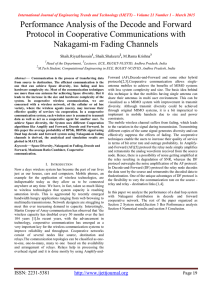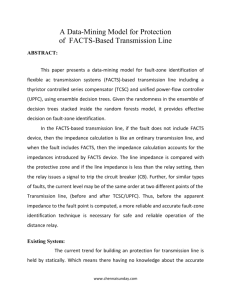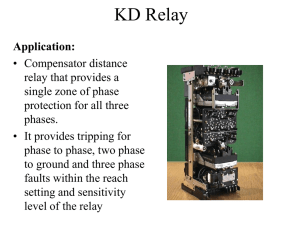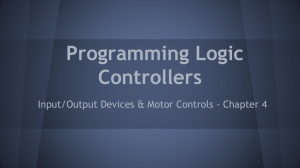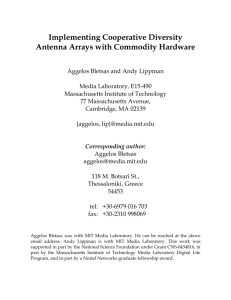- the Journal of Information, Knowledge and Research in
advertisement
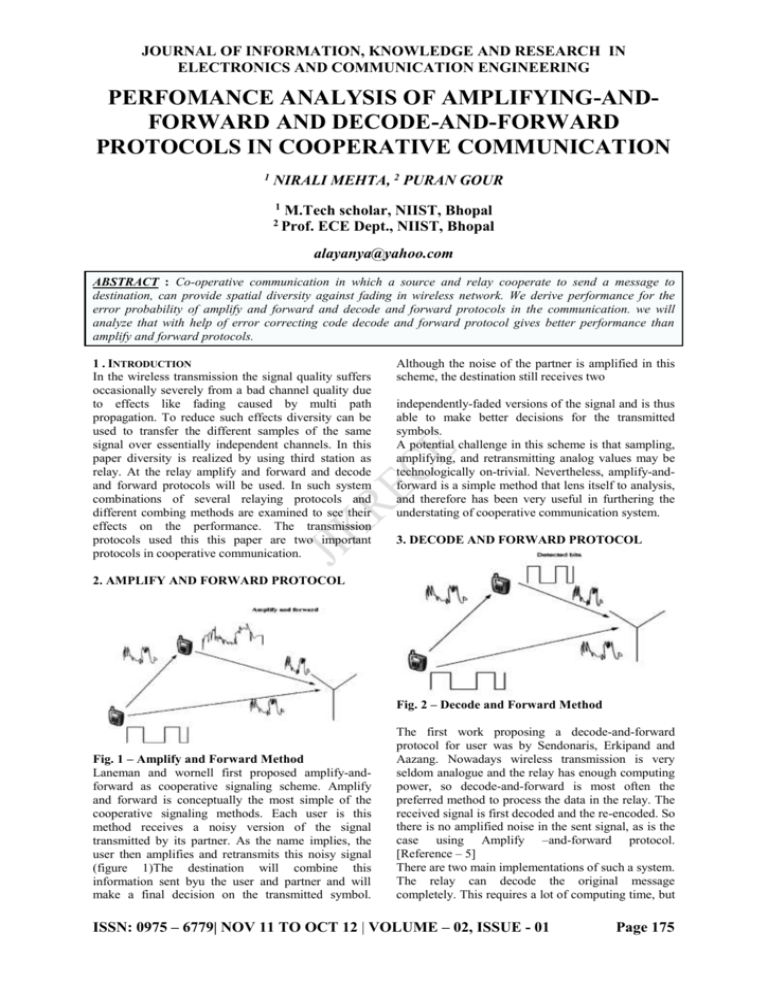
JOURNAL OF INFORMATION, KNOWLEDGE AND RESEARCH IN ELECTRONICS AND COMMUNICATION ENGINEERING PERFOMANCE ANALYSIS OF AMPLIFYING-ANDFORWARD AND DECODE-AND-FORWARD PROTOCOLS IN COOPERATIVE COMMUNICATION 1 NIRALI MEHTA, 2 PURAN GOUR 1 M.Tech scholar, NIIST, Bhopal ECE Dept., NIIST, Bhopal 2 Prof. alayanya@yahoo.com ABSTRACT : Co-operative communication in which a source and relay cooperate to send a message to destination, can provide spatial diversity against fading in wireless network. We derive performance for the error probability of amplify and forward and decode and forward protocols in the communication. we will analyze that with help of error correcting code decode and forward protocol gives better performance than amplify and forward protocols. 1 . INTRODUCTION In the wireless transmission the signal quality suffers occasionally severely from a bad channel quality due to effects like fading caused by multi path propagation. To reduce such effects diversity can be used to transfer the different samples of the same signal over essentially independent channels. In this paper diversity is realized by using third station as relay. At the relay amplify and forward and decode and forward protocols will be used. In such system combinations of several relaying protocols and different combing methods are examined to see their effects on the performance. The transmission protocols used this this paper are two important protocols in cooperative communication. Although the noise of the partner is amplified in this scheme, the destination still receives two independently-faded versions of the signal and is thus able to make better decisions for the transmitted symbols. A potential challenge in this scheme is that sampling, amplifying, and retransmitting analog values may be technologically on-trivial. Nevertheless, amplify-andforward is a simple method that lens itself to analysis, and therefore has been very useful in furthering the understating of cooperative communication system. 3. DECODE AND FORWARD PROTOCOL 2. AMPLIFY AND FORWARD PROTOCOL Fig. 2 – Decode and Forward Method Fig. 1 – Amplify and Forward Method Laneman and wornell first proposed amplify-andforward as cooperative signaling scheme. Amplify and forward is conceptually the most simple of the cooperative signaling methods. Each user is this method receives a noisy version of the signal transmitted by its partner. As the name implies, the user then amplifies and retransmits this noisy signal (figure 1)The destination will combine this information sent byu the user and partner and will make a final decision on the transmitted symbol. The first work proposing a decode-and-forward protocol for user was by Sendonaris, Erkipand and Aazang. Nowadays wireless transmission is very seldom analogue and the relay has enough computing power, so decode-and-forward is most often the preferred method to process the data in the relay. The received signal is first decoded and the re-encoded. So there is no amplified noise in the sent signal, as is the case using Amplify –and-forward protocol. [Reference – 5] There are two main implementations of such a system. The relay can decode the original message completely. This requires a lot of computing time, but ISSN: 0975 – 6779| NOV 11 TO OCT 12 | VOLUME – 02, ISSUE - 01 Page 175 JOURNAL OF INFORMATION, KNOWLEDGE AND RESEARCH IN ELECTRONICS AND COMMUNICATION ENGINEERING has numerous advantages. If the source message contains an error correcting code, received bits errors might be corrected at the relay station. Or if there is no such code implemented a checksum allows the relay to detect if the received signal contains errors. Depending on the implementation an erroneous message might not be sent to the destination. But it is not always possible to fully decode the source message. The additional delay caused to fully decode and process the message could be coded to protect sensitive data. In such a case, the incoming signal is just decoded and re-encoded symbol by symbol. Amplify and Forward versus Decode and Forward Fig. 3 – Comparison between Amplify-andForward Method and decode-and-forward method Normally the performance of the AAF diversity protocol compared with DAF protocol is better. As per the figure if we use error correcting code with the DAF protocol than it will give the better performance than AAF protocol. The comparison is based on the bit error rate and signal to noise ratio of the signal. AAF is often used when the relay has only limited computing time/power available or the time delay, caused by the relay to de- and encoded the message, has to minimized. Of course when an analogue signal is transmitted a DAF protocol is not used. [Reference – 2] The idea behind the AAF protocol is simple. The signal received by the relay was attenuated and needs to be amplified before it can be sent again. In doing so the noise in the signal is amplified as well. which is the main downfall of this protocol. Nowadays a wireless transmission is very seldom analogue and relay has enough computing power, so DAF is most often the preferred method to process the data in the relay. The received signal is first decoded and then re-encoded. So there is no amplified noise in the sent signal, as is the case using a AAF protocol. There are two main implementations of such a system. [Reference – 7] The relay can decode the original message completely. This requires a lot of computing time, but has numerous advantages. If the source message contains an error correcting code, received bit errors might be corrected at the relay station. DAF gives better performance than AAF protocol. 4. REFERENCES [1] Cao and B. Vojcic, “Cooperative coding using serial concatenated convolutional codes,” in Proc. of Wireless Commun. And Networking Conf., New Orleans, LA, Mar. 2005, pp. 1001–1006. [2] A. stefanov and E. Erkip, “Cooperative coding for Wireless networks,” IEEE Trans. Commun., vol. 52, no. 9, sept. 2004. [3] M. Janani, A. Hedayat, T.E. Hunter and A. Nosratinia, “Coded Cooperation in wireless Communication: spacetime transmission and Iterative decoding” IEEE Trans. Signal Processing, vol. 52, no. 2, pp 362–371, Feb. 2004. [4] A. Sendonaris, E. Erkip, and B. Aazhang, “User Cooperation diversity- Part II: Implementation Aspects and performance analysis,” IEEE Trans. Commun., vol. 51, no. 11, pp. 19391948, Nov 2003. [5] A. Sendonaris, E. Erkip and B.Aazhang, “User Cooperation diversity-Part I: System description, IEEE Trans. Commun., vol. 51, no. 11, pp. 19271938, Nov 2003. [6] T. E. Hunter and A. Nosratinia, “Cooperative Diversity Through coding,” in Proc. IEEE International Symposium On Information Theory (ISIT), Laussane, Switzerland, July 2002, p. 220. [7] J. N. Laneman, G. W. Wornell, and D. N. C. Tse, “An Efficient Protocol for Realizing Cooperative Diversity in Wireless Networks,” Proc. IEEE ISIT, Washington, DC, June 2001, p. 294. [8] J G Proakis, “Digital Communication 4ed,” MH 2001. [9] A. E. G. T Cover,, “Capacity theorems for the Relay Channel, IEEE Trans. Inf. Theory, vol. IT-25, No. 5, pp. 572584, Sep 1979. [10]E. C. van der Meulen “Three terminals Communication Channels,” Adv.Appl. Prob, vol. 3, pp. 120154, 1971. ISSN: 0975 – 6779| NOV 11 TO OCT 12 | VOLUME – 02, ISSUE - 01 Page 176


